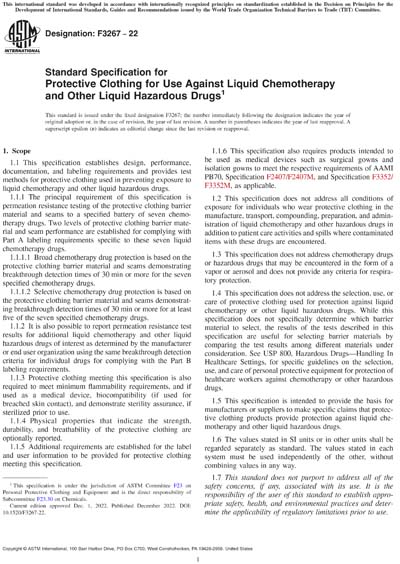Most recent
ASTM F3267-22
Standard Specification for Protective Clothing for Use Against Liquid Chemotherapy and Other Liquid Hazardous Drugs
1.1This specification establishes design, performance, documentation, and labeling requirements and provides test methods for protective clothing used in preventing exposure to liquid chemotherapy and other liquid hazardous drugs.
1.1.1The principal requirement of this specification is permeation resistance testing of the protective clothing barrier material and seams to a specified battery of seven chemotherapy drugs. Two levels of protective clothing barrier material and seam performance are established for complying with Part A labeling requirements specific to these seven liquid chemotherapy drugs.
1.1.1.1Broad chemotherapy drug protection is based on the protective clothing barrier material and seams demonstrating breakthrough detection times of 30 min or more for the seven specified chemotherapy drugs.
1.1.1.2Selective chemotherapy drug protection is based on the protective clothing barrier material and seams demonstrating breakthrough detection times of 30 min or more for at least five of the seven specified chemotherapy drugs.
1.1.2It is also possible to report permeation resistance test results for additional liquid chemotherapy and other liquid hazardous drugs of interest as determined by the manufacturer or end user organization using the same breakthrough detection criteria for individual drugs for complying with the Part B labeling requirements.
1.1.3Protective clothing meeting this specification is also required to meet minimum flammability requirements, and if used as a medical device, biocompatibility (if used for breached skin contact), and demonstrate sterility assurance, if sterilized prior to use.
1.1.4Physical properties that indicate the strength, durability, and breathability of the protective clothing are optionally reported.
1.1.5Additional requirements are established for the label and user information to be provided for protective clothing meeting this specification.
1.1.6This specification also requires products intended to be used as medical devices such as surgical gowns and isolation gowns to meet the respective requirements of AAMI PB70, Specification F2407/F2407M, and Specification F3352/F3352M, as applicable.
1.2This specification does not address all conditions of exposure for individuals who wear protective clothing in the manufacture, transport, compounding, preparation, and administration of liquid chemotherapy and other hazardous drugs in addition to patient care activities and spills where contaminated items with these drugs are encountered.
1.3This specification does not address chemotherapy drugs or hazardous drugs that may be encountered in the form of a vapor or aerosol and does not provide any criteria for respiratory protection.
1.4This specification does not address the selection, use, or care of protective clothing used for protection against liquid chemotherapy or other liquid hazardous drugs. While this specification does not specifically determine which barrier material to select, the results of the tests described in this specification are useful for selecting barrier materials by comparing the test results among different materials under consideration. See USP 800, Hazardous Drugs - Handling In Healthcare Settings, for specific guidelines on the selection, use, and care of personal protective equipment for protection of healthcare workers against chemotherapy or other hazardous drugs.
1.5This specification is intended to provide the basis for manufacturers or suppliers to make specific claims that protective clothing products provide protection against liquid chemotherapy and other liquid hazardous drugs.
1.6The values stated in SI units or in other units shall be regarded separately as standard. The values stated in each system must be used independently of the other, without combining values in any way.
1.7This standard does not purport to address all of the safety concerns, if any, associated with its use. It is the responsibility of the user of this standard to establish appropriate safety, health, and environmental practices and determine the applicability of regulatory limitations prior to use.
1.8This international standard was developed in accordance with internationally recognized principles on standardization established in the Decision on Principles for the Development of International Standards, Guides and Recommendations issued by the World Trade Organization Technical Barriers to Trade (TBT) Committee.
Content Provider
ASTM International [astm]






